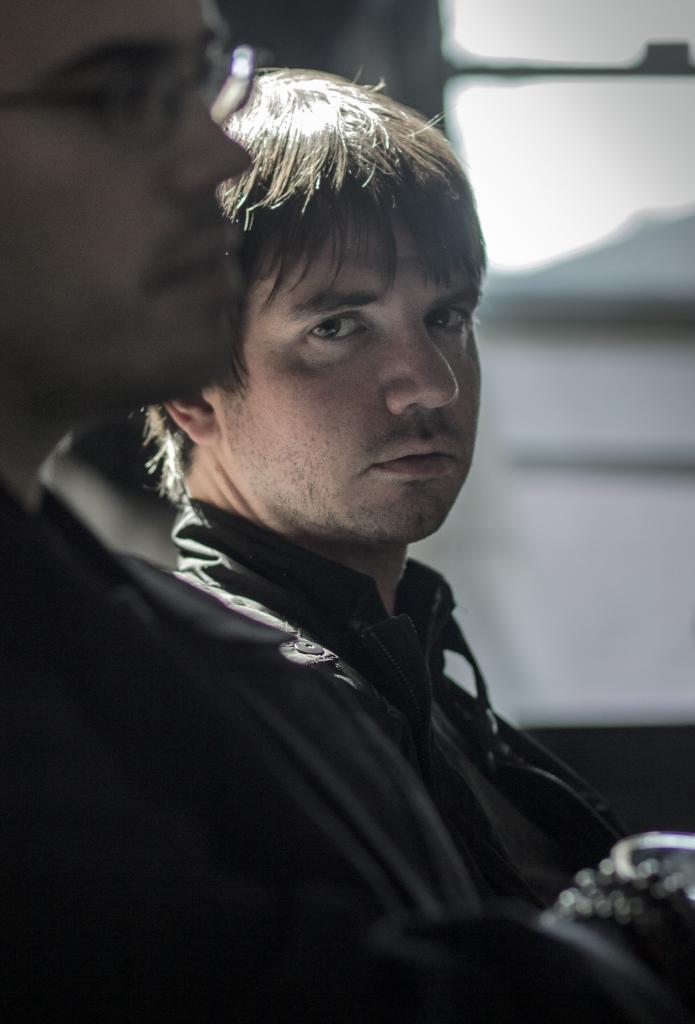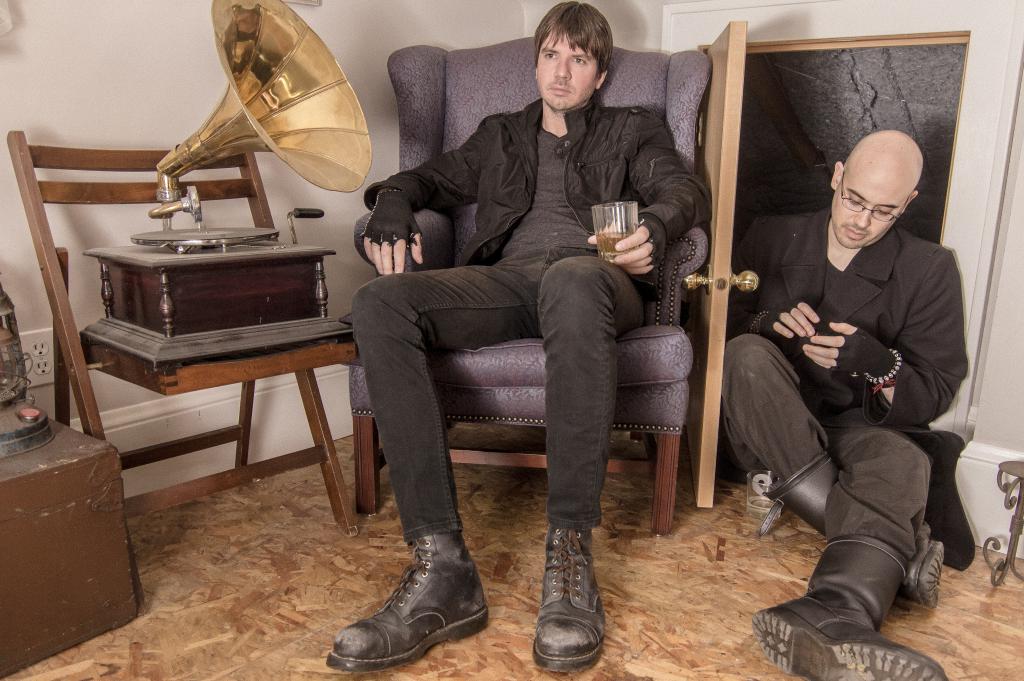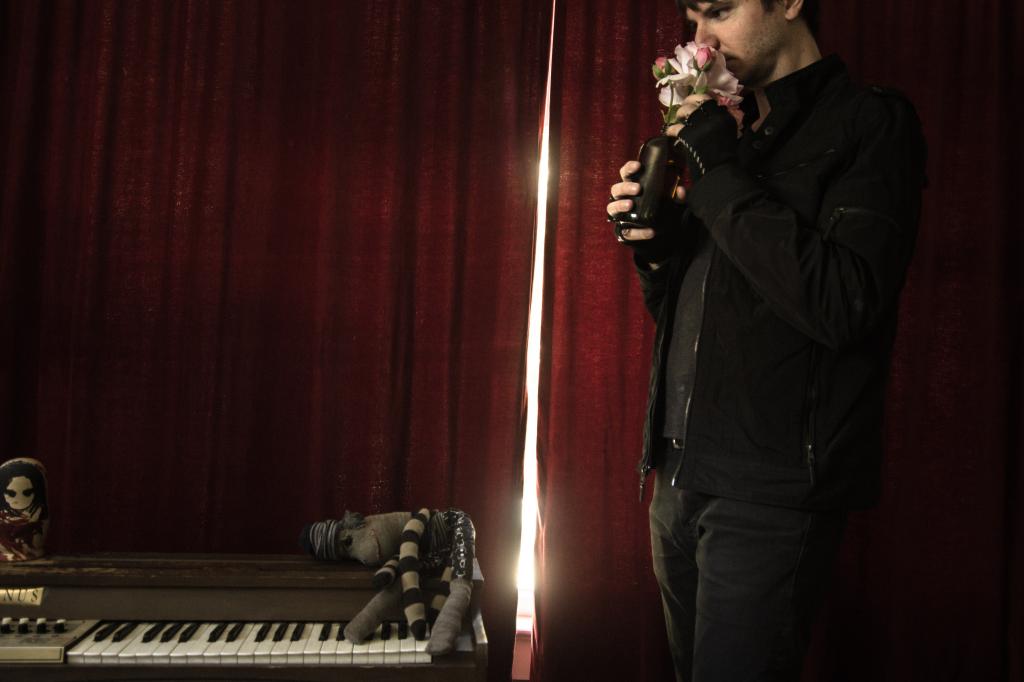Behind the scenes with Michael Holloway of Dead When I Found Her
by outsider on Jan.16, 2013, under Spotlight
 Dead When I Found Her is the project of Michael Arthur Holloway. The music project started some time ago when he turned 30 years old. Michael’s musical direction with the DWIFH project was very specific. He had been writing and recording music for a long time but was always restless; jumping from idea to idea. In his younger years he admitted to a lack discipline. He lacked the ability to commit to a project and see it through to the end.
Dead When I Found Her is the project of Michael Arthur Holloway. The music project started some time ago when he turned 30 years old. Michael’s musical direction with the DWIFH project was very specific. He had been writing and recording music for a long time but was always restless; jumping from idea to idea. In his younger years he admitted to a lack discipline. He lacked the ability to commit to a project and see it through to the end.
“I had years during my twenties when the only music I worked on was guitar-based indie rock stuff. I had periods where my only musical output was scoring local short-films my friends made. My attention span always wandered.” Michael said.
After returning home from South America, he felt that a new leaf needed to be turned in his musical expression, and was ready to pursue one musical project and see it all the way through. He felt the discipline and the ability to organize his ambitions into something cohesive was there. And the musical choice for Michael was singular; it had to be an old-school industrial band.
“That was the one kind of music that had stuck with me through the years, it was still the kind of music that inspired me and affected me the most. I approached this project with a level of discipline and follow-through that I’d never had in the past. It made all the difference.” Michael said.
The road that Michael walked in his teenager years getting introduced to industrial music is much the same as most of us that got introduced to the same music in the nineties. Nine Inch Nails, Skinny Puppy (which Michael admits has been his favorite band his whole life) are the confirmed suspects as well as Project Pitchfork and Mentallo and the Fixer to name a few. The elements that Michael gravitated towards were bands and albums which exhibited a strong focus on melody, songwriting and atmosphere. Not surprising as his current album makes use of all those elements.
“I was really obsessed with Project Pitchfork for a while there. ‘IO’ was a favorite of mine, and still is. Also ‘Alpha+Omega’ and ‘Chakra: Red’.” Michael told me.
He continued “As for Mentallo, ‘Where Angels Fear to Tread’ is an absolute classic, and I still play it regularly. Their sound was so unique, such an interesting mix of accessible and inaccessible elements.”
Being particularly specific from the onset of the project allowed Michael to ‘focus’ his energy and creativity. Zero-ing in on the end-product becomes easier as the result is measurable. Defining your ambitions leads you to where you are going.
Michael elaborated “If you sit down to create art and set out to make anything, you’ll always succeed, because you just made something. If you set out to make one, challenging, specific kind of thing, you’ll know exactly when you’ve succeeded, and when you’ve failed. And I’ve found that it’s very intensely satisfying, as an artist, to choose a very specific goal and then nail it.”
Michael feels very satisfied with what he’s accomplished, which just means that he’s hit the nail on the head with regards to his personal standards being met.
With all serious projects there is a serious investment of time, energy and intense focus that goes into the work. The music writing process for Michael starts with writing sketches of songs. He’s written more then he can count and within that pool, sometimes something will stand out. Something will excite Michael and it gets developed further. He describes there being a “magic” moment where he would just know that the sketch he’s working on will become an actual complete track. It’s a sense that it contains something special, something great that begs for completion. The remaining sketches however, are not without purpose. Some get picked apart and used as cool drum loops, or pad progressions, others just help develop sequences and patches to be used elsewhere. Nothing is wasted.
The gross steps in Michael’s music creation workflow are: create sketches, build select sketches into songs (add samples, melody and atmosphere), add lyrics.
“The whole thing can be summed up with: Michael spends hours and hours sitting in front of his computer, often turning to play the keys on his midi controller.” Michael said jokingly.
There; the secret is out. You too can now create music like Michael.

After living in Bogota Colombia, Buenos Aires Argentina and throughout Guatemala in his late 20’s, Michael returned to Portland, Oregon which is where he considers home to be.
“The original impetus for the move to South America was, as is so often the case, a girl. But it evolved and expanded from there into an interest in being away from home, learning a new language, deliberately feeling apart from what I knew and building up from scratch.” Michael told me.
“Going through that experience of basically building an entire life from scratch in a brand new place is really exciting and challenging, and you learn a whole lot about yourself while doing it.” He added.
Since melody and atmosphere are placed above all other elements, it’s not surprising that Michael’s workflow reflects that. A basic rhythm is first created to define the tempo and groove of the track, then he quickly shifts to finding the core musical progression that will serve as the backbone for the track.
“I go back later and flesh out the rhythms, but I try to make sure I get something musical and memorable going early on, because when you just have a pile of rhythms, you eventually realize you’re not songwriting, you’re just making beats as the kids say these days, and that doesn’t really go anywhere unless you shift deliberately toward songwriting.” Said Michael.
The whole process is almost instinctual and very natural flowing (when things are going well) in that a feeling is guiding the process rather than thought.
With the current album Rag Doll Blues Michael has been focusing a lot on sampling as an art form.
“Synthesizers are a beautiful thing, no doubt; but if you ask me, samplers and sampling provide the beating, bloody heart of industrial music. What often bothers me about the current state of the genre is how many bands have apparently forgotten this. These two instruments are not interchangeable, even if their functionality overlaps in many ways.” Michael told me.
“Listen to an album like ‘Last Rights’, and you’ll hear a thousand unique, fascinating sounds from god knows where; voices, drones, blips, screams, crashes, and things no word can describe. They play along with the synth-basslines and synth-pads, and are mostly responsible for the incredible atmosphere and texture of the whole experience. Now listen to most ‘industrial’ bands today, and all you get is synth bass line, synth lead, synth pad, a drum track, and vocals on top. Where’d the texture go? The atmosphere? The crazy indescribable warped sounds?” Michael earnestly said.
Through the years Michael’s musical workflow has changed as he’s experimented with different software but nothing hit home like Albeton Live did.
“It changed my life. I know that sounds silly, but it’s absolutely true. I bought Ableton at the same time I started DWIFH. I wanted a new program for a new project. The workflow in Ableton was a revelation to me. It connected as an artistic tool in a way nothing before ever had. Everything from DWIFH has been written and produced in Ableton Live. I’d marry it if I could.” Michael told me.
He really would. And he could go on all day about why he feels so strongly about this one piece of software. Software needs to make the artists (be it composer or producer) workflow feel smooth, natural and fast as workflow is everything when it comes to efficient music writing.
But what about the lyrics and movie samples that permeate the DWIFH musical landscape, you ask?
The samples play an integral role in the acoustic direction each track takes and are heavily used during the instrumental composition of the song. They are chosen for the specific atmospheric effect and Michael is very meticulous and conscious about this process.
“I group the samples within a song based on the content of the sample, almost as if by choosing the dialog samples I’m arranging chunks of lyrical themes, but allowing the spoken samples to provide the actual lyrical content.” Michael said.
The samples are arranges in lyrical theme chunks to allow them to provide actual lyrical content.
“The atmospheric effect of adding samples is enormous; you really feel the whole tone of the work shift into something new.” Michael said.
Samples are used liberally for everything from melodic to textural elements to sound effects.
Having built up a library of samples Michael just needs to dip into it to grab stuff that suits the current song. Every now and again he’ll do a streak of sampling from a bunch of movies to add to the library which is getting to be quite large.
Lyrics are the last step in the music writing process and are the result of Michael immersing himself in the music he’s written and then lets the vibe of the tracks guide his imagination to what lyrics would fit. When he finds a theme/vibe he likes words get put to paper. For Rag Doll Blues the recurring theme is childhood and the memory of it.

Michael knows what he likes and doesn’t like when it comes to music.
“I don’t want to sound like a total snob, but I think (some) people are just plain getting lazy. The lack of emphasis on texture, atmosphere and sound design is symptomatic of people just not bothering to invest much energy in those areas—and settling for boring trance leads to play melodies with. I just can’t get into that. There are lots of band in the genre that I’ll hear once, and lose interest immediately, simply because of the kinds of sounds they are using. Every day, generic ‘synth’ sounds: trance lead, soft pad, virus bass, over vengeance kick drum. Your songwriting / melodic hook or vocals have to be really, really great to overcome the limitations (or just boring-ness) of those sound sources.” He said. You have to respect and appreciate the dedication and attention to the craft that this man brings to the music he creates.
“When I was a little kid, back in the eighties, my father had a collection of dubbed cassette tapes that I discovered: Music for the Masses by Depeche Mode, an album by Yello (the one with the Ferris Bueller ‘oh yeah’ song), Deep Breakfast by Ray Lynch, and a lot of New Age music. Those tapes shaped my life from that point forward. The emotional connection to synthesizers and electronic textures was immediate for me. It got under my skin and has been there ever since.” Michael told me.
There was a distinct lack of formal musical training in Michael’s younger years. All his talents are self-taught which range from guitar to keys. When he was 17, a Kurzweil K2000 came into his possession which allowed his strong desires to make electronic music become a reality. In his twenties the guitar took the stage of Michael’s interest and indie rock was the main course.
“I developed a lot of skills during that time, (his twenties) and learning new instruments always adds to your overall musical vocabulary, so it all plays a part, even if I don’t’ make that kind of music.” Michael said.
Outside of making music Michael is human like the rest of us; video games, whiskey, horror movies and Ridley, his very cuddly and often very demanding tuxedo cat with an eating disorder.
You will find Michael at the local hipster bar the Bye & Bye hanging out with friends, and he does visit The Lovecraft (Portland’s local goth-industrial bar where everyone knows him; like Norm in Cheers). When you do run into him buy him a glass of Bulleit Bourbon; it will put you in his good books. Also a good topic of conversation is Albeton Live. Ask him to tell you about the Session View sequencer and what it brings to the music creation process for him.
Touring has been a mixed bag for DWIFH. Opening for some of the bigger name bands often felt like a job for Michael. He’s not being critical of anyone; it’s just the reality of things.
“We’re just some local band who got stuck on the bill in the middle of their exhausting US tour. They didn’t show up in Portland to make new friends.” Michael said.
A sentiment I am sure most bands experience through their touring career.
Performing on a stage was a new experience for Michael (in the early touring days of DWIFH), as he had never done anything similar in his life. The first few opening-spot gigs brought out the nerves.
“If anything I actually feel a bit detached up there now, as if my mind is sort of elsewhere while I get this thing done, ha. It certainly is something that improves with experience: you loosen up, move around more, feel free to experiment more in your presentation.” He said.
As for taking DWIFH on the road, the live experience is kept pretty simple; John C. Worsley (same guy who does all the artwork for the project) plays live keys and Michael does the vocals and plays guitar.
“Literally everything is powered through a macbook pro running Ableton Live: the guitar and vocals get processed in there and John plays keys on a midi controller keyboard that triggers different instruments at different times. If the laptop shuts down, we have effectively zero audio output on stage—including even the vocals, since they are processed in there. It’s dangerous, but it’s the way we need to do it at this point.” Michael said.
John also puts together a synchronized video track with clips from horror movies, which plays in the background. There’s lately been some experimentation with a live drummer which may make it into future live shows.
As for the future of DWIFH, Michael will continue to challenge himself musically while exploring the medium. The exploration will likely produce elements which will make the DWIFH sound more aggressive and chaotic and generally darker.
“So there’s a part of me that really wants the challenge of making a whole album of very heavy music. It would still be musical, I’m not talking power noise here, and it would still have all the layers and depth, but it would be notably intense, overwhelming, cathartic.” Michael said.
Think of Convulsion by Skinny Puppy, the Broken EP by NIN or H.O.M.M. by Kalte Farben.
“I want the next album to be an emotional experience– both for me making it, and for the listener.” Michael told me.
Michael is not one to settle down in a comfortable rhythm and churn out similar sounds album to album. Expect growth from him as his modus operandi is to always “challenge yourself”.
With bated breath I will be awaiting the next release from Michael and DWIFH.
Interview by: Adrian Onsen



